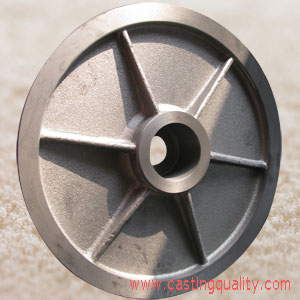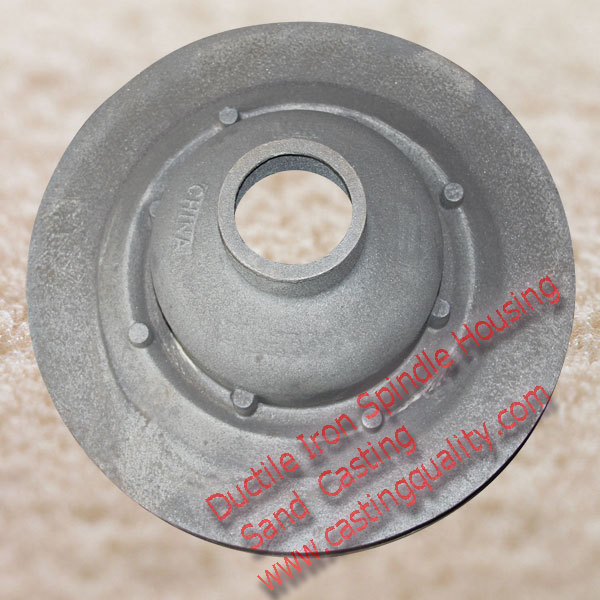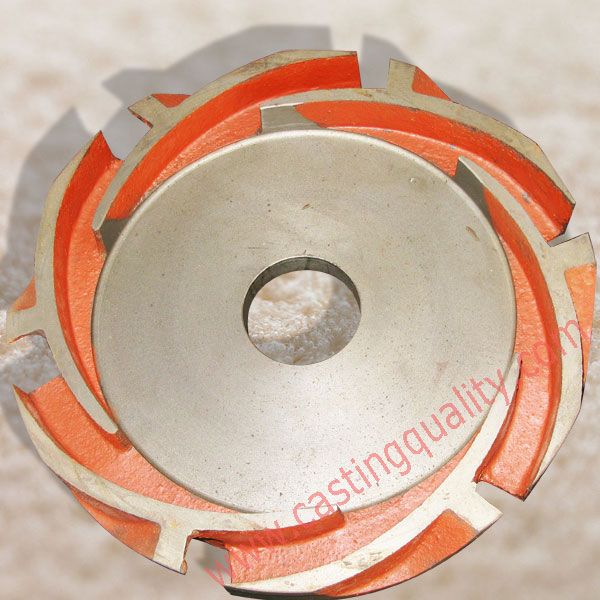Introduction of Grey Iron in EN 1561
Grey Iron castings in EN 1561 is mainly iron and carbon based, carbon being present mainly in the form of flake (lamellar) graphite particles, also named known as flake graphite cast iron, and less commonly as lamellar graphite cast iron. It’s popular gray iron material in European standard.
Manufacture Process for Grey Iron in EN 1561
- Sand Casting
- Shell Casting
- Lost Foam Casting

Our Services
- Sand Casting
Casting Quality focus on Metal Parts industry, we provide professional service in Metal Casting field.
Sand Casting is a popular metal form method, are suitable for all materiel, such as grey iron, ductile iron, malleable iron, carbon steel, stainless steel, aluminum and bronze.
- Investment Casting
Also named as precision lost wax casting, mainly suitalbe for carbon steel and stainless steel parts. We also provide grey iron and ductile iron and aluminum and bronze parts by investment casting. It can achieve the best appearance with good tolerance
- Shell Casting
Shell casting method is a good option to replace investment casting and sand casting. the quality is better than sand casting parts, suitable for bulk production.
- Permanent Mold Casting
For aluminum parts and Brozne parts
- CNC Machining
CNC Milling, CNC turning with 5 xix CNC center, we provide precision machining for all castings based on customers design drawings.
- CAD Design
Mechanical Design service based on customers requirement, our software is Solidworks and AutoCAD.
- Tools/Mold Design
Mould design and production will be served for metal casting ad plastic injection industry. Based on our more than 10 years experience, we supply professional molds for our customers in Europe and North American.
Standard of Grey Iron
EN 1561:2023 Founding – Grey cast irons
Grey Iron in EN 1561 Equivalent Material Grades
| ISO 185:2004 | ISO 185:1988 | EN 1561 | ASTM A48 | JIS G5501 | SAE J431 | GB/T 9439:2010 |
| ISO 185/JL/150 | 150 | EN-GJL-150 | 150 | FC150 | G9H12 | HT150 |
| ISO 185/JL/200 | 200 | EN-GJL-200 | 200 | FC200 | G10H18 | HT200 |
| ISO 185/JL/225 | – | – | 225 | – | G10/21/G11H18 | HT225 |
| ISO 185/JL/250 | 250 | EN-GJL-250 | 250 | FC250 | G11H20 | HT250 |
| EN 1561/JL/275 | – | – | 275 | – | G12H21/G13H19 | HT275 |
| ISO 185/JL/300 | 300 | EN-GJL-300 | 300 | FC300 | G13H22 | HT300 |
| ISO 185/JL/350 | 350 | EN-GJL-350 | 350 | FC350 | G13H24 | HT350 |
| ISO 185/JL/HBW155 | H145 | EN-GJL-HB155 | – | – | H10 | H155 |
| ISO 185/JL/HBW175 | H175 | EN-GJL-HB175 | – | – | H11 | H175 |
| ISO 185/JL/HBW195 | H175/H195 | EN-GJL-HB195 | – | – | H13/H14 | H195 |
| ISO 185/JL/HBW215 | H175/195/215 | EN-GJL-HB215 | – | – | H15 | H215 |
| ISO 185/JL/HBW235 | H195/215/235 | EN-GJL-HB235 | – | – | H18 | H235 |
| ISO 185/JL/HBW255 | H215/235/255 | EN-GJL-HB255 | – | – | H20 | H255 |
Grey Iron in EN 1561 Material Physical Property
| Property of grey cast irons | EN-GJL-150 | EN-GJL-200 | EN-GJL-250 | EN-GJL-300 | EN-GJL-350 | |
| Mass Density; kgs/dm3 | 7.10 | 7.15 | 7.20 | 7.25 | 7.30 | |
| Specific heat capacity; J/(kgK) Between 20℃and 200℃ Between 20℃and 600℃ | 460 535 | |||||
| Linear expansion coefficient; um/(mK between -100℃ and +20℃ between 20℃ and 200℃ between 20℃ and 400℃ | 10.0 11.7 13.0 | |||||
| Thermal Conductivity; W/(mk) At 100℃ At 200℃ At 300℃ At 400℃ At 500℃ | 52.5 51.0 50.1 59.0 48.5 | 50.0 49.0 48.0 47.0 46.0 | 48.5 47.5 46.5 45.0 44.5 | 47.5 46.0 45.0 44.0 43.0 | 45.5 44.5 43.5 42.0 41.5 | |
| Resistivity; Ω·mm2/m | 0.80 | 0.77 | 0.73 | 0.70 | 0.67 | |
| Coercivity; A/m | 560 to 720 | 560 to 720 | 560 to 720 | 560 to 720 | 560 to 720 | |
| Maximum permeability; μH/m | 220 to 330 | 220 to 330 | 220 to 330 | 220 to 330 | 220 to 330 | |
| Hysteresis losses at B=1T; J/m3 | 2500 to 3000 | 2500 to 3000 | 2500 to 3000 | 2500 to 3000 | 2500 to 3000 | |
Grey Iron in EN 1561 Chemical Composition Requirements
No standard specifies the chemical composition, so we only recommend the following composition based on actual production.
| Grade | Wall Thickness (mm) | C | Si | Mn | P ≤ | S ≤ |
| EN-GJL-100 | – | 3.4~3.9 | 2.1~2.6 | 0.5~0.8 | 0.3 | 0.15 |
| EN-GJL-150 | <30 30~50 >50 | 3.3~3.5 3.2~3.5 3.2~3.5 | 2.0~2.4 1.9~2.3 1.8~2.2 | 0.5~0.8 0.5~0.8 0.6~0.9 | 0.2 0.2 0.2 | 0.12 0.12 0.12 |
| EN-GJL-250 | <30 30~50 >50 | 3.2~3.5 3.1~3.4 3.0~3.3 | 1.6~2.0 1.5~1.8 1.4~1.6 | 1.7~0.9 0.8~1.0 0.8~1.0 | 0.15 0.15 0.15 | 0.12 0.12 0.12 |
| EN-GJL-300 | <30 30~50 >50 | 3.0~3.3 2.9~3.2 2.8~3.1 | 1.4~1.7 1.3~1.6 1.2~1.5 | 0.8~1.0 0.9~1.1 1.0~1.2 | 0.15 0.15 0.15 | 0.12 0.12 0.12 |
| EN-GJL-350 | <30 30~50 >50 | 2.9~3.2 2.9~3.2 2.8~3.1 | 1.4~1.7 1.2~1.5 1.1~1.4 | 0.8~1.0 0.9~1.1 1.0~1.2 | 0.15 0.15 0.15 | 0.10 0.10 0.10 |
Grey Iron in EN 1561 Mechanical Property
The material can be defined using two methods: a) the tensile strength in separately casting; b) the hardness of material.
| Material Designation | Wall thickness mm | Tensile strength Value to be obtained | |||
| Symbol | Number | Over | Up to | In separately cast or side-by –side casting sample (N/mm2) | In cast-on samples (N/mm2) |
| EN-GJL-100 | 5.1100 (EN-JL1010) | 5 | 40 | 100 to 200 | – |
| EN-GJL-150 | 5.1200 (EN-JL1020) | 2.5 | 5 | 150 to 250 | – |
| 5 | 10 | – | |||
| 10 | 20 | – | |||
| 20 | 40 | 125 | |||
| 40 | 80 | 110 | |||
| 80 | 150 | 100 | |||
| 150 | 300 | 90 | |||
| EN-GJL-200 | 5.1300 (EN-JL1030) | 2.5 | 5 | 200 to 300 | – |
| 5 | 10 | – | |||
| 10 | 20 | – | |||
| 20 | 40 | 170 | |||
| 40 | 80 | 155 | |||
| 80 | 150 | 140 | |||
| 150 | 300 | 130 | |||
| EN-GJL-250 | 5.1301 (EN-JL1040) | 5 | 10 | 250 to 350 | – |
| 10 | 20 | – | |||
| 20 | 40 | 210 | |||
| 40 | 80 | 190 | |||
| 80 | 150 | 170 | |||
| 150 | 300 | 160 | |||
| EN-GJL-300 | 5.1302 (EN-JL1050) | 10 | 20 | 300 to 400 | – |
| 20 | 40 | 250 | |||
| 40 | 80 | 225 | |||
| 80 | 150 | 210 | |||
| 150 | 300 | 190 | |||
| EN-GJL-350 (Removed in EN 1561: 2023) | (EN-JL1060) | 10 | 20 | 350 to 450 | 315 |
| 20 | 40 | 280 | |||
| 40 | 80 | 250 | |||
| 80 | 150 | 225 | |||
| 150 | 300 | – | |||
Brinell hardness of castings of grey cast irons:
| Grade material | Wall thickness (mm) | Brinell hardness (HB 30) | |||
| Symbol | Number | Over | Up to | Min | Max |
| EN-GJL-HB155 | 5.1101 (EN-JL2010) | 2.5 | 5 | – | 210 |
| 5 | 10 | 185 | |||
| 10 | 20 | 170 | |||
| 20 | 40 | 160 | |||
| 40 | 80 | 155 | |||
| EN-GJL-HB175 | 5.1201 (EN-JL2020) | 2.5 | 5 | 170 | 260 |
| 5 | 10 | 140 | 225 | ||
| 10 | 20 | 125 | 205 | ||
| 20 | 40 | 110 | 185 | ||
| 40 | 80 | 100 | 175 | ||
| EN-GJL-HB195 | 5.1304 (EN-JL2030) | 5 | 10 | 170 | 260 |
| 10 | 20 | 150 | 230 | ||
| 20 | 40 | 135 | 210 | ||
| 40 | 80 | 120 | 195 | ||
| EN-GJL-HB215 | 5.1305 (EN-JL2040) | 5 | 10 | 200 | 275 |
| 10 | 20 | 180 | 255 | ||
| 20 | 40 | 160 | 235 | ||
| 40 | 80 | 145 | 215 | ||
| EN-GJL-HB235 | 5.1306 (EN-JL2050) | 10 | 20 | 200 | 275 |
| 20 | 40 | 180 | 255 | ||
| 40 | 80 | 165 | 235 | ||
| EN-GJL-HB255 | 5.1307 (EN-JL2060) | 20 | 40 | 200 | 275 |
| 40 | 80 | 185 | 255 | ||
Grey Iron in EN 1561 Heat Treatment Requirement
Generally, the castings are supplied without heat treatment. For some special applications, the heat treatment shall be agreed at the time of ordering, it can be to reduce internal stress or hardening, quenching and tempering for improving machinability.
Grey Iron in EN 1561 Application
- Pumps and valves
- Lathe bed, engineer blocks.
- Industrial machinery parts.
- Flywheels.
- Automotive
- Cookware, electrical boxes, bearing, bushing.
- Construction parts.
Grey Iron Machinability:
Very good, easy for machining such as milling, turning or drilling.
Grey Iron Weldability:
Very bad. Generally, castings welding require the purchaser’s approval. The welding process and the filler metals should be appropriated to the use of the casting in manner intended.
As a professional manufacturer in China, We Casting Quality focus on Metal Parts OEM industry, and provide solutions and services in Metal Casting field as following:
- Sand Casting
- Investment Casting, Lost Wax process
- Shell Casting
- Lost Form Casting
- CNC Machining
- CAD Design
- Tools/Mold Design
Material Supplied
- Cast Iron Castings (Grey Iron, Malleable Iron, Ductile Iron)
- Carbon Steel and Alloy Steel Castings
- Stainless Steel and Duplex Stainless Steel Castings
- Aluminum Castings
- Bronze and Brass Castings
- Titanium and Cobalt Alloy Castings
What We Can Do
- Design Ability
Our engineers will help you to improve the designs based on casting technology, then The simulation software will be processed to verify the casting pouring system. Pro/E, Solidworks, AutoCAD and ProCast are available in Casting Quality Industrial.
- Saving Cost
Some manufacture processes may lead high cost. We will analyse the designs and advise the suitable methods to our customers. The best solution will be adopted.
- Quality Control
From the raw material selecting to bulk production processing, all procedures will follow PPAP program if necessary. The certificates will be provided including chemistry, hardness, mechanical property or NDT testing.
- Production Capacity
The max iron/steel castings can reach 30tons in weight, meanwhile the minus casting is around 1gram only.
We also have prototyping and 3D scanning ability for sample plan.
- Logistic Service
The products will be delivered directly to customer’s workshop, which will save plenty of work for clients.

 PDF VIEW
PDF VIEW




